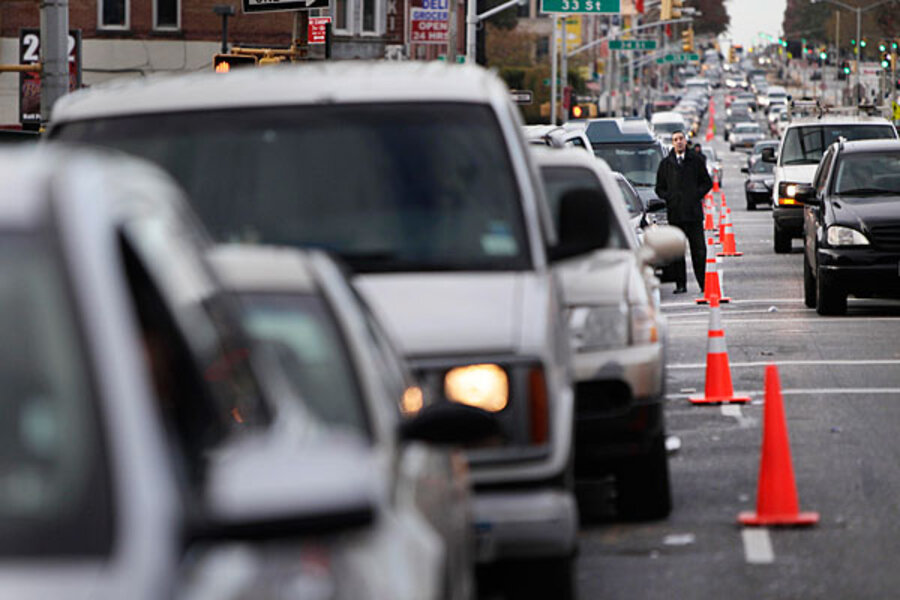Why hours-long lines for gasoline aren't easing in Sandy-hit areas
Loading...
| New York
At least in theory, some of those mile-long waits for gasoline in the New York metro area should start to diminish.
As of Thursday, the US Coast Guard had opened the port of New York to barges carrying petroleum products. In the wake of superstorm Sandy, the Coast Guard needed to make sure all the aids to navigation were in the right place.
Opening up the port means that raw gasoline can move to terminals where it gets blended with ethanol and other additives. Then, tanker trucks can start to move gasoline to places where motorists can tank up.
“That solves a lot of the problems,” says Sander Cohan, a principal at Energy Security Analysis, Inc. in Wakefield, Mass.
It can’t come soon enough for drivers – many of them taxi drivers – waiting outside a Hess station at 45th Street and 10th Avenue in Manhattan. One line of cars stretched for 26 blocks – about 1.3 miles.
Mamouolon Kaba, a taxi driver, had been in line for six hours. He just shook his head in dismay at his waste of time. Another taxi driver, Bolivar Villacis, explained that he was required to return the car to his garage with a full tank for the next driver. He was in a shorter line – only 2-1/2 hours.
“I’m not making any money while I’m here,” he said as police officers tried to prevent cars from jumping the line.
Unfortunately, the fuel arriving in the next few days won’t solve all the problems.
Many gasoline stations in the Sandy-ravaged area still don’t have electricity, which is necessary to power the pumps. In addition, some refineries that supply gasoline to the area are still closed because of damage. And it does not take long for gasoline stations to go through their supplies when motorists are lined up for miles.
“The system was not designed for everyone to buy fuel at the same time,” says Jeff Lenard, vice president of the National Association of Convenience Stores in Washington. Most gasoline is sold at convenience stories such as 7-11 or WaWa nationwide.
Mr. Lenard says most tanker trucks carry about 10,000 gallons of fuel. He estimates it takes the average motorist about 6 minutes to fill up their car. At a typical eight-pump station, he estimates the average gas station in the New York area is going through 800 to 1,000 gallons per hour now.
“That means the typical store has about 10 hours of supply,” says Lenard.
Lenard says it’s understandable that gasoline stations have run low. “Mass transit is still hobbled if not crippled,” he says, “so people don’t have other options other than their cars.”
In addition, Lenard says it’s human nature to react to a line at a gas station. “People see the line and wonder if they should get in it,” he says.
Some of the worst places for gasoline lines are in New Jersey and Long Island, says Avery Ash, manager of regulatory affairs AAA in Washington. He says 45 percent to 50 percent of gas stations are operational in the Garden State while 35 percent to 40 percent are operational on Long Island. This is a slight improvement from Thursday.
“It means they operated at some point today, but it does not mean they had gasoline all day,” he says. “This continues to be an issue of electricity,” says Mr. Ash.
The Long Island Power Authority (LIPA), which supplies most of the electricity for Long Island, says it does not expect to get most residents back on its grid until the weekend of Nov. 10 at the earliest.
“Many gasoline stations have plenty of gas in their tanks but they can’t turn the pumps on,” says Ash.
Getting gasoline from local refineries, which are the closest, is not going to be that easy either.
According to the daily situation report from the Department of Energy, as of Friday two New Jersey refineries accounting for 308,000 barrels of gasoline – about 25 percent of supply to the New York metro area – remained closed.
In addition, some storage facilities have been damaged. Motiva, a joint venture between Shell and Saudi Refining, says two of four diesel-storage facilities in Sewaren, N.J., are leaking.
On the positive side, two gasoline pipelines that bring gasoline from Gulf Coast refineries are just starting to reopen. They were shut down in advance of the storm.
However, Ash points out that the pipelines cannot operate at full capacity because some of the pipeline terminals are still closed. In an effort to help, the US government temporarily suspended the Jones Act, which requires that vessels moving between US ports must be US-flagged. The suspension means that foreign-flagged vessels can help move gasoline from refineries in Houston to New York harbor.
The waiver of the Jones Act resulted in the wholesale prices of gasoline falling 5.5 cents a gallon on Friday. “That’s the lowest price since late June,” says Ash.
In fact, despite the long lines and short tempers, Ash says he has not heard of gasoline stations gouging consumers.
“Until today, gasoline prices were continuing to fall in New York and New Jersey,” he says. On Friday, gasoline prices in both states were up about 1 cent per gallon compared with Thursday. But there were about 2 cents a gallon lower than last week.
“We continue to think prices will come down through the end of the year,” he says.







